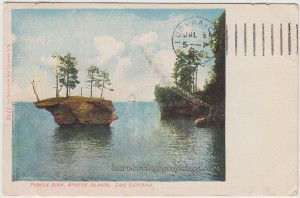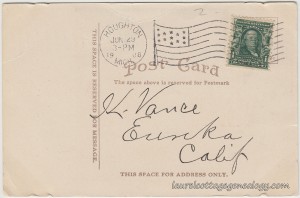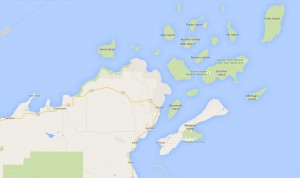Divided back, used postcard. Outgoing postmark June 29, 1908 from Houghton, Michigan and receiving postmark July 5, 1908 at Eureka, California. Publisher: E. C. Kropp Co., Milwaukee, Wisconsin. Number 1115.
Price: $12.00
Another for Ida
This is the second in our small Ida L. Vance Collection, and shows what appears to be a colored image produced from a photo. Note the sailboat on the horizon: This vessel looks like it was drawn in or maybe it was a faint image that was outlined. In any case, this 1908 postcard shows a view of Profile Rock, situated off the northern shore of Basswood Island in the Apostle Islands of Wisconsin. The profile appears on the right-hand side of the rock. You can see the prominent nose and ridge over the eye. (It looks like he is staring into the water.) Below is a map of the islands courtesy of Google.
A sea stack
The name for this type of rock formation is “sea stack” which is formed by weathering and erosion. Imagine a rock wall that has a cave-like indentation; the waves knocking against the rock on both sides and water seeping in any fissures; the passage of time creating a hole in the rock, gradually getting bigger, creating an arch. At some point, the weight of the arch becomes too great, breaking and falling into the sea, or in this case Great Lake, and voila, you are left with a sea stack.
Old-school for a minute
Discovering ancestral ties to the Michigan and Ontario, Canada, Lake Superior region on Dad’s side some years ago, led to the purchase of a number of books on the Ojibwe people which grace the bookshelf not five feet away (so dramatic, chuckle) from where I sit typing this in our little cottage. Besides naturally wanting to learn about a fascinating culture and history, the books were bought in hopes of finding some mention of our direct ancestor, Chief Na-ges-sis, whose daughter Ikwe-wa-ni-gen-its married Louis Majeau, French-Canadian voyageur for the Northwest Company. Alas, there was no mention of Na-ges-sis found, but it strikes as such a refreshing novelty, for this post research, to be able to refer to a set of books in one’s own living room, just a glance away….Not to say that the internet is not extremely well-appreciated – essential nowadays for research. But the most interesting Apostle Island reference on the shelf was found in Kitchi-Gami, Life Among The Lake Superior Ojibway, an account by German geographer, ethnologist and travel writer, Johann Georg Kohl, when he stayed on Madeline Island (then called La Pointe) for four months in 1855:
From the rank of princes
“La Pointe belongs to a larger group of islands, which the French missionaries named Les Isles des Apôtres. They play a great part in the Indian traditions, and seem to have been from the earliest period the residence of hunting and fishing tribes, probably through their geographical position and the good fishing in the vicinity. The fables of the Indian creator, Menaboju, often allude to these islands, and the chiefs who resided here have always laid claim, even to the present day, to the rank of princes of the Ojibbeways…..The great fur companies, too, which, after them, ruled on Lake Superior, had one of their most important stations at La Pointe; more especially the once so powerful North-West Company, which carried on a lively trade from this spot as far as the Polar Seas.”
Many names for the Rock
From John Lindquist’s excellent webpage, Views of the Apostle Islands, Profile Rock “…has also been called Lone Rock, Floating Rock, and Honeymoon Rock – the last name being the most commonly applied today.” (We wonder too, what the native tribes called it.) Lindquist quotes J. M. Turner on the importance of Profile Rock to the Indians,
“It was thought…that when they were encamped on the island in front of the face that no harm could befall them. This belief had such a firm hold upon the Indians of this whole region that when a band of fugitives were hard pressed and likely to fall into the hands of their pursuers they would always fly to the protected camping grounds within the sight of the Great Stone Face well knowing that no enemy would dare to molest them once they were there. “
One last note
Just to clarify regarding the aforementioned Chief Na-ges-sis and daughter, they are thought to have been centered around the Straights of Mackinac area in Michigan (not the Apostles) though Louis Majeau, in his travels with the Northwest Company, must surely have made stops at La Pointe. There was a little confusion in the past about the birthplace of one of the daughters of Louis Majeau and Ikwe-wa-ni-gen-its: Madeleine Majeau’s marriage record to Henry Campau looks like it may say Madeleine’s birthplace was, “des Îles du lac Superieur” from which it was thought that she was born on one of the islands near Mackinac, but if you really scrutinize the original handwriting, and look at the transcribed copy (also in French) you’ll see it actually says, “des issus du lac Superieur” meaning from the Lake Superior area. Just mentioning this for anyone researching this line, and in the hopes that some reference may at some point turn up for more on Chief Na-ges-sis. And, of course, this Madeleine was a different woman than the one the Apostle island was named for. Madeline (formerly La Pointe) Island was named after the wife of French-Canadian trader Michel Cadotte, she also being the daughter of Chief White Crane. (John Lindquist’s webpage link above has a photo of the historical plaque regarding the same.
Sources: Apostle Islands. Google Maps.
Caves, arches, stacks and stumps. GCSE Bitesize. Web accessed August 1, 2015.
Kohl, Johann G., Kitchi-Gami. Life Among The Lake Superior Ojibway. 1860. Trans. Lascelles Wraxall. Saint Paul, MN: Borealis Minnesota Historical Society Press, 1985.
Lindquist, John. Views of the Apostle Islands. Web accessed August 2, 2015.
Turner, J.M. Lake Superior Region. Ashland, WI: W.E. Prudhomme, 1892.
Moll, Harold W. and Norman G., Lewis and Batteese Mashue, Father and Son, Through Fur and Saginaw Valley Timber. Unpublished collection assembled and bound by Michigan State Library, 1954 – 1958.
Ste. Anne, Detroit, Michigan, U.S.A. (1801-1842) p. 1949-1950. U.S., French Catholic Church Records (Drouin Collection), 1695-1954. (Ancestry.com)



